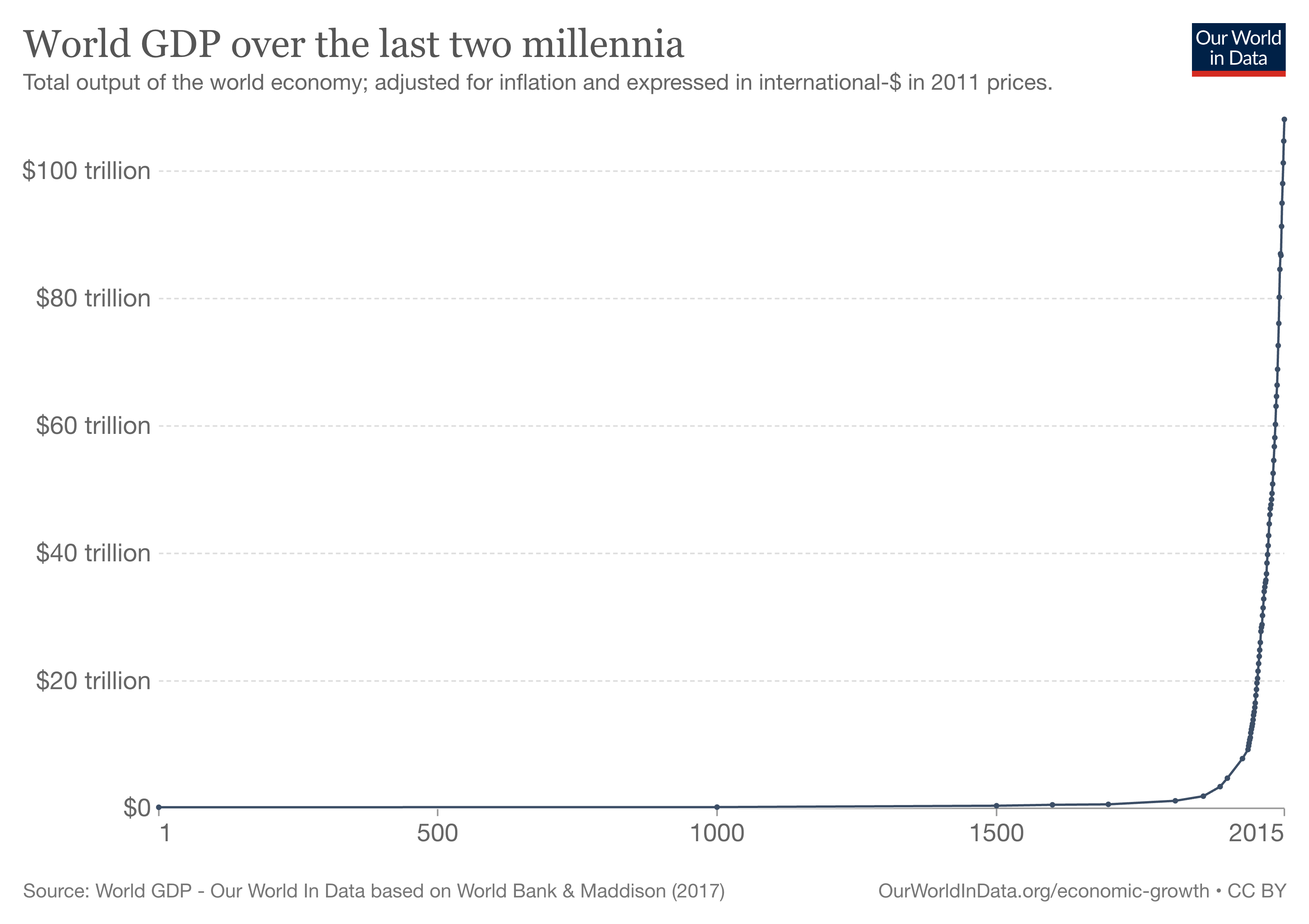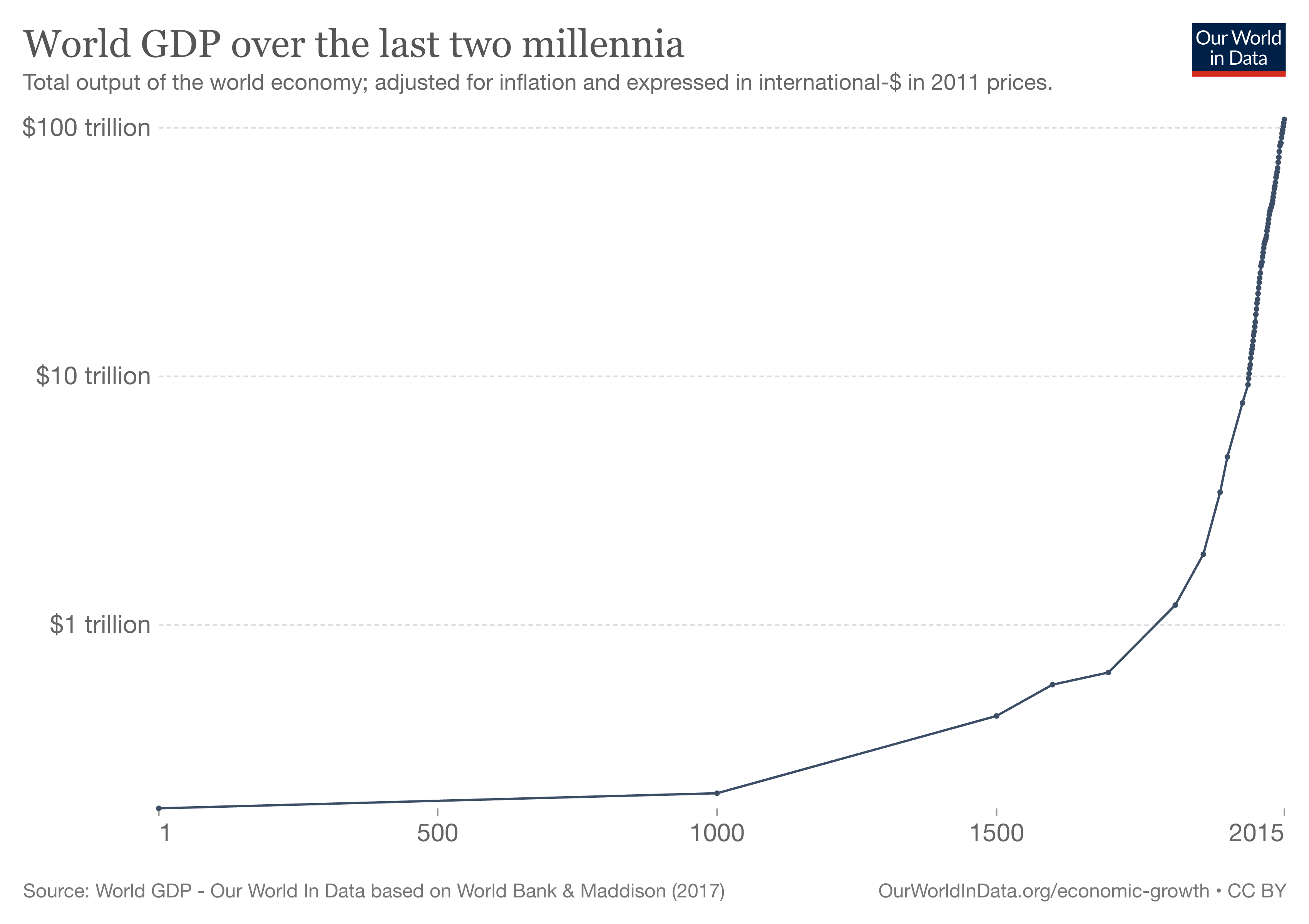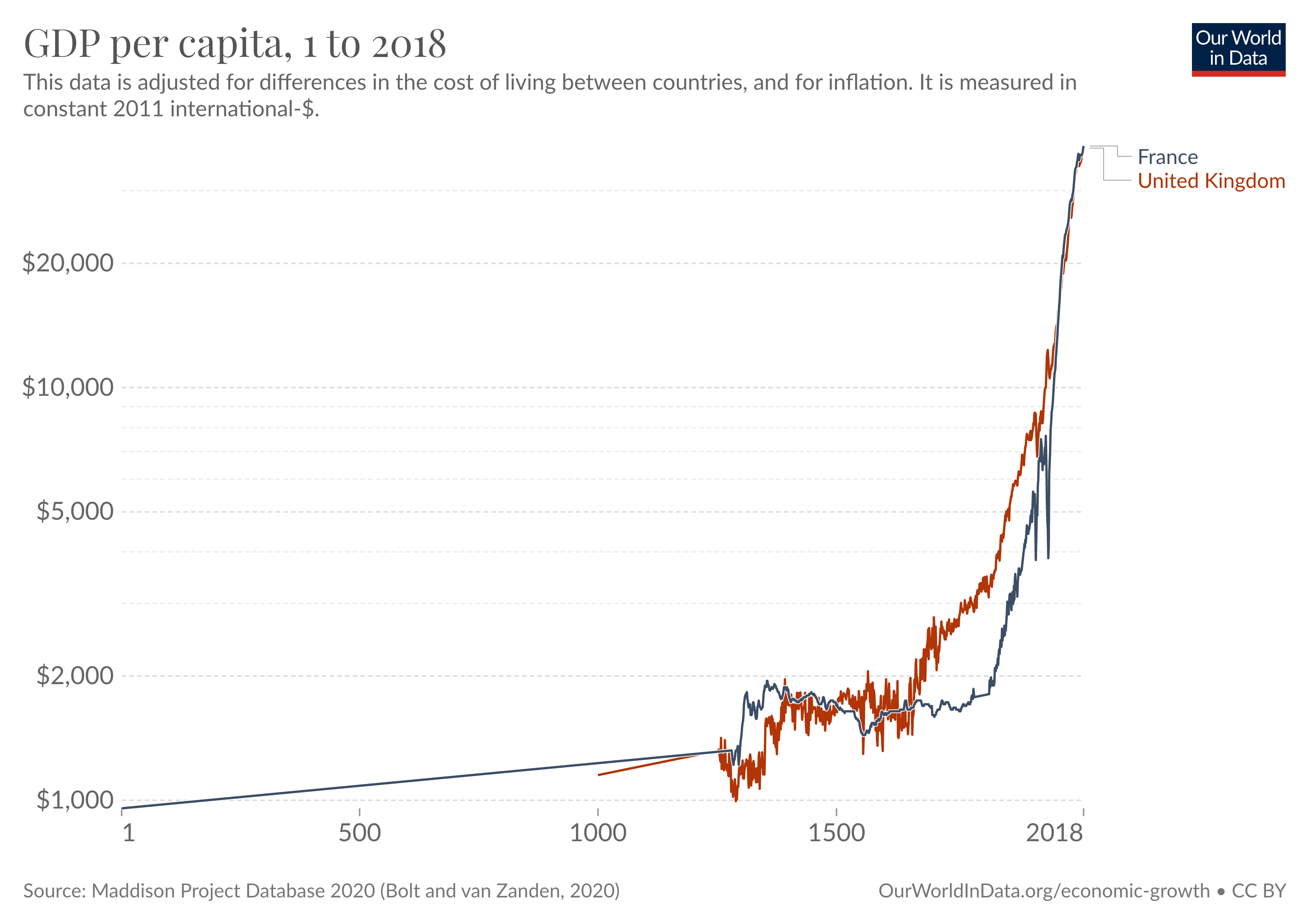What explains the hockey-stick shape of world GDP over time, with seemingly no progress for thousands of years, followed by soaring growth?

The first question you might ask is: is this just an exponential curve? If so, then the explanation is simple: we see a constant growth rate every year, and the steep upward slope is just what exponential curves look like. There’s no more mystery than there would be about the shape of a population curve.
To check this, we can plot the same numbers on a logarithmic y-axis. In such a chart, exponential curves become straight lines. But when we do this, we still see an upwards slope. That is, the growth rate has increased over time:

Nor is it just a consequence of population growth, because we see the same pattern in GDP per capita:

I’ve previously said that a core reason for this is that progress compounds, creating a flywheel effect. Here’s another way of looking at the same idea. Why wasn’t the threshing machine invented in, say, the 1300s? Consider all the barriers to such a thing:
Human capital
First, who would have invented it?
Would it have been a farmer? (Well over half the workforce were farmers.) When would he have found the time to tinker? Labor productivity and incomes were low; there wasn’t much spare time or material for inventing.
Who else could have done it? There was no established professional class of inventors, engineers, or entrepreneurs. The closest were skilled craftsmen who made machines, such as clockmakers or millwrights. Overall there were many fewer inventors per capita than today (ok, I don’t have data on this right now, but I’m pretty confident in this assertion).
If it were, say, a millwright, he would have to learn enough about machines to go beyond the kinds that he had been taught to make through apprenticeship, and invent something entirely new. Where would this knowledge have come from? There was no printed material, and no mechanics’ institutes.
And if our inventor did have mechanical skill, why why would he decide to apply it to a practical invention for farmers? It was more prestigious and lucrative to make clockwork novelties for the aristocracy. Even if the inventor did have a practical bent, there were social taboos against labor-saving devices.
Manufacturing
Suppose that despite all of this, some inventive person is determined to make a threshing machine and acquires the resources and time to experiment. Maybe he avoids the trap of making a machine that mimicks human motions, and hits on the idea of a rotating drum with teeth.
He will find that making the machine work reliably is very difficult. It requires a high degree of skill in the mechanic that crafts it by hand. There are no machine tools to create precision parts. Wood is too soft for precision work; metal parts are required. Machines that are shoddily constructed break easily or bruise the grain instead of threshing it. (See my full post on the threshing machine for elaboration.)
Distribution
Suppose our inventor overcomes all these obstacles, and manages to create a practical threshing machine. What next?
He could use it on his own farm, if he is a farmer. If that’s all he does, then his invention has had no significant impact on the economy and no impact at all on history. This is not what we are seeking to explain.
To matter for progress, the invention needs to be distributed. And here our inventor faces more obstacles.
Who is the market for his invention? Will other farmers be receptive to it? They need to change their methods and take a risk on something new, something they are not used to doing.
Even if they are willing to take that risk, do they have the capital? Buying a piece of agricultural equipment is an investment that won’t pay off right away. Do farmers have enough money saved for such an investment? Likely not, given low incomes, and there is no financial infrastructure to give loans for such purposes. Would such an investment even pay off on a small farm? It may require a certain level of scale to be worth it.
Market creation
But suppose there is a market that is willing and able to pay for threshing machines. How would our inventor, now turned entrepreneur, serve that market?
He may be able to serve his village or town, through word of mouth and local dealings. But that small market is probably not enough to support a business dedicated to threshing machines—and again, if only one town were served, it would have a limited impact on progress. Our aspiring threshing machine tycoon needs to server a larger, regional or even national market.
How is he going to promote his product? There are no newspapers or other media, not even the printing press. There may be occasional local fairs (although, again, the attendees are typically not prepared to consider new inventions).
If potential customers do hear about the product, how do they order one? There is no postal service to send messages or money. Similarly, how would the product be transported to the customer from wherever it is assembled? There are no locomotives, and the wagon roads are in poor condition. River or canal transport might be possible, but that won’t go the last mile to each customer.
And if the business takes off, will our entrepreneur be able to source enough raw materials to keep up production? All of the problems of finding customers apply to finding suppliers as well.
Financial and legal infrastructure
Even if these obstacles could be overcome, the entrepreneur is going to need capital to get started. And again, there is very little in the way of any kind of financial market to support speculative investments like this.
Suppose our plucky hero is very enterprising and decides to crowdfund his effort by collecting small investments from a large number of people. He has no way to form a corporation for this purpose, because corporate law has not yet been developed. (A partnership would not be practical with a large number of partners, especially since there was no limited liability.)
If there were the infrastructure needed to start businesses, the entrepreneur might find himself facing competition from others who steal his ideas and copy his machine. If he had royal favor, he might be granted a monopoly, but there was no patent office where he could send an application, nor any established rule awarding patents to inventions.
And if he overcame all of the above obstacles, he might find that he faced opposition from those whom his progress threatened, such as farmhands who took on manual threshing work. They might oppose him by seeking legal restrictions on his business, or by illegal means such as smashing and burning machinery. (I don’t know of this happening to threshing machines, but it certainly happened to textile machinery.) Would the government come to the aid of the inventor, or of the displaced workers, or would they stay out of the whole affair?
How progress actually happened
If we fast-forward through the centuries, we can see how the underpinnings of progress were gradually established. The threshing machine makes a good example because it was an obvious idea that struggled for a long time to be born, so we can see the stages it went through:
By the 1600s at the latest, the idea of applying mechanical ingenuity to practical problems was well established, and we can see people talking about the idea of threshing machines (although I have seen no evidence that any were working yet).
By the 1700s, there were at least a few mechanics in existence who had the skill to create a working threshing machine, but they were only serving their local area. Others announced projects to distribute plans and models for the machine, but they did not expect to make this a business, and instead asked for donations to support the work. By this point there were newspapers where such schemes could be advertised, and postal service for individuals to communicate about them.
By the early 1800s at least, there were inventor/entrepreneurs who had patented threshing machines and were trying to make a business of them. There were farmer’s journals that discussed such inventions and improvements, and many farmers were eager to try new things to improve their productivity. But there was still very little manufacturing capacity, and inventors such as Joseph Pope were still offering to sell plans which could be implemented by a local workman. Soon after, though, Pope was contracting with a specialized machine shop, an engine manufacturer, to make his machine.
By the mid-1800s, railroads would be established that could ship the machines to customers over a wide area. It’s around this time that threshing machines become widely adopted.
Today
To really drive the point home, imagine that the problem of mechanizing threshing had been completely overlooked for the last few hundred years, while all other progress moved forward.
The threshing problem would be solved almost instantly.
There is an entire professional class of entrepreneurs looking for opportunities exactly like this. It would be easy for them to look up data on agricultural processes and cost drivers, and to find that a very large part of grain cost was manual threshing. It would be obvious that this should be mechanized.
Designing the machine would be no problem—there are many professionals with bachelors’ degrees in mechanical engineering who could do the job. They would have standard parts to choose from out of a catalog, such as gears and motors, and they could specify the design quickly and precisely using CAD software. Any specialized parts could be 3D-printed for rapid prototyping. Manufacturing would similarly be no problem, thanks to the enormous infrastructure we have built up for this.
Three companies to solve this problem would be in the next batch for Y Combinator. They would each form a Delaware C-corporation with a simple filing and some standard legal documents, raise millions of dollars within a few days by meeting with investors over Zoom, sign a contract online through DocuSign, and have the money wired immediately to a bank account they set up in twenty minutes with Mercury.
They would establish a website to market the product, complete with spec sheets, promotional videos, etc. They could get a list of the biggest agricultural companies and reach out to them directly by email, promote the product online using targeted advertisements, and fly to large international trade shows to exhibit there. They could take orders online as well, and ship anywhere via UPS, FedEx, or DHL. They would have a global market from day one.
And their customers would be ready, even eager, for such an innovation. They would be used to the idea of saving costs through better technology. They would have full financial accounting statements to show them where their biggest costs are. They would have executives and program managers whose jobs include evaluating new technologies and buying them. There would be standard legal agreements, purchase orders, and payment mechanisms.
In sum, the road for this kind of progress has already been paved—both metaphorically and literally.
The roots of progress?
All of this has been an illustration of the many, overlapping, interacting flywheels of progress that generate super-exponential growth over the very long term.
What I am much less clear on is which of these factors, if any, can be seen as derivative and which are fundamental—if some were inevitable given other, enabling factors. This is a much harder question to answer.
But even if we could answer that, it wouldn’t change the fact that all of these factors are real and important, and progress depends on all of them working together.

Great essay! And clearly you put your elbow grease in to make it flow and feel right rhetorically. Mwah. That catalogue of hurdles was very well thought out.
I have one comment on the following:
"If it were, say, a millwright, he would have to learn enough about machines to go beyond the kinds that he had been taught to make through apprenticeship, and invent something entirely new. Where would this knowledge have come from?"
I was just listening to Esther Duflo talk about mathematics ability and difference between street kids who sell produce and students in school. The 10 year old math practitioner in the streets can solve very complex practical problems involving two divisions, an additions, and a subtraction quickly with a high degree of accuracy. But in the study which ratcheted up the abstraction layers of the question to the practitioners, they quickly fell off as the questions became more abstracted out (even when given monetary incentive to solve the problem!).
Similarly students in school weren't able to climb down the ladder from abstraction to application. And when they tried, they needed pen and paper and took 10 minutes to figure it out.
This study once again indicates the difficulty of transfer. What is learned in one area only with conscious and deliberate practice can be applied to another.
But another more subtle takeaway is possible, namely that the vast majority of millwrights don't engage in philosophical abstraction of the art of millwrighting, hunting for foundational and transferable principles to other fields. You present it as a 'knowledge problem'. Perhaps we can get even more precise. It's that millwrights don't teach their apprentices general principles, because they themselves never did formulate explicit general principles about machines. Until there are general principles, there are few inventors. It's a science problem. Technique without science is sterile.
The Hamming Principle: Archimedes requires Euclids, not Euclids Archimedes.
I think this flows directly into why it seems intuitive that new ideas are getting harder to find. For example, all the obvious ideas in mobile apps were explored as businesses from 2005~2015, and it's hard to think of a genuinely new mobile app concept that isn't just a variation on an established business.
If you were trying to, say, disrupt the taxi industry using computer technology in 1998, you would run into a big lack of infrastructure. Would people request a taxi from a website? Then people couldn't request a taxi without visiting a place such as a PC cafe. There would be no way to process payments. There would be no way to track drivers using GPS -- which did exist, but there were no internet-connected wireless GPS devices. In fact, how would you communicate with the drivers? By cell phone? Would you hire human dispatchers? What's the value add on top of phone-dispatched taxis then?
Clearly, there was a right time to start a computer-enhanced taxi service, and that time was 2005~2015. By 2015, the idea had been had.
Yes, I agree. But note that new breakthrough technologies open up whole new fields of ideas that are suddenly “easy to find”—as per your very example. So another way to look at the question is what affects the rate of growth in new fields.